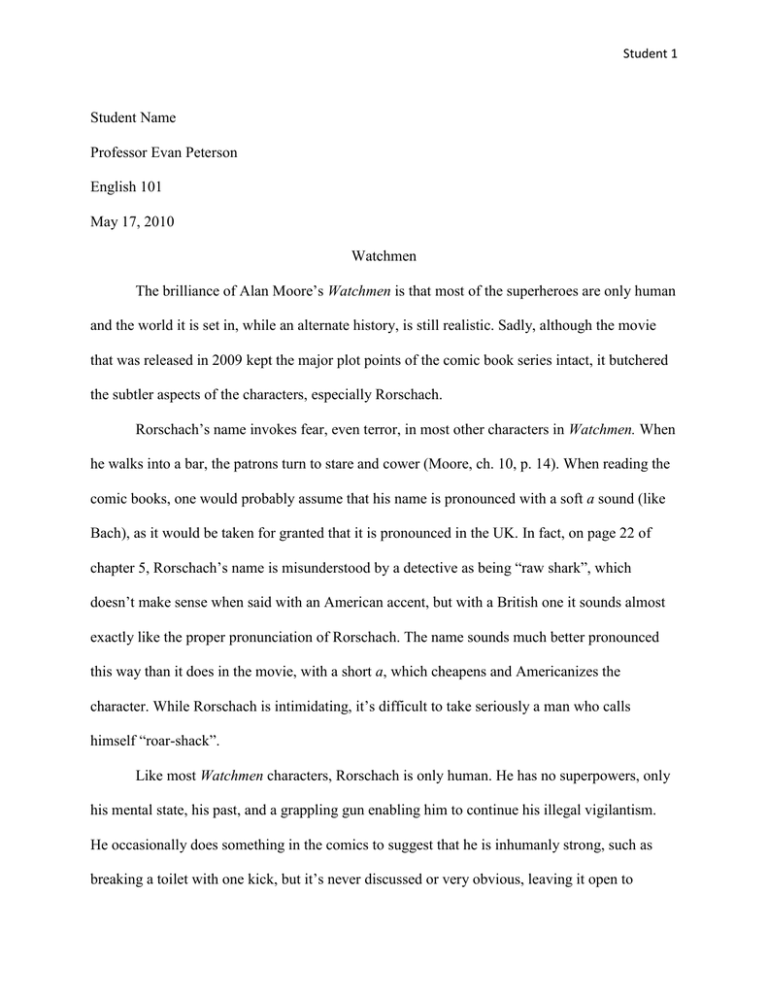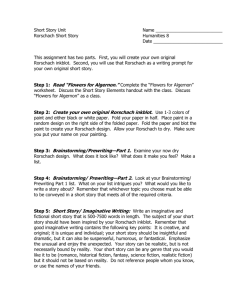Student Name Professor Evan Peterson English 101 May 17, 2010
advertisement

Student 1 Student Name Professor Evan Peterson English 101 May 17, 2010 Watchmen The brilliance of Alan Moore’s Watchmen is that most of the superheroes are only human and the world it is set in, while an alternate history, is still realistic. Sadly, although the movie that was released in 2009 kept the major plot points of the comic book series intact, it butchered the subtler aspects of the characters, especially Rorschach. Rorschach’s name invokes fear, even terror, in most other characters in Watchmen. When he walks into a bar, the patrons turn to stare and cower (Moore, ch. 10, p. 14). When reading the comic books, one would probably assume that his name is pronounced with a soft a sound (like Bach), as it would be taken for granted that it is pronounced in the UK. In fact, on page 22 of chapter 5, Rorschach’s name is misunderstood by a detective as being “raw shark”, which doesn’t make sense when said with an American accent, but with a British one it sounds almost exactly like the proper pronunciation of Rorschach. The name sounds much better pronounced this way than it does in the movie, with a short a, which cheapens and Americanizes the character. While Rorschach is intimidating, it’s difficult to take seriously a man who calls himself “roar-shack”. Like most Watchmen characters, Rorschach is only human. He has no superpowers, only his mental state, his past, and a grappling gun enabling him to continue his illegal vigilantism. He occasionally does something in the comics to suggest that he is inhumanly strong, such as breaking a toilet with one kick, but it’s never discussed or very obvious, leaving it open to Student 2 interpretation whether he has any superhuman abilities or not (Moore, ch. 8, p. 17, fr. 5). In the movie, however, his movements are frequently too fast or obviously too strong to be those of a human. Even in the very beginning of the movie when Rorschach uses his grappling hook to climb up the building where The Comedian was killed, this difference between the movie and the comic is obvious. In the comic book, Rorschach climbs through the window as a normal person would, sitting on the ledge and holding onto the window frame so as not to plummet to his death. Rorschach in ch. 1, p. 6, fr. 1 Although this scene in the movie is incredibly similar, there are a few notable differences. Instead of climbing through the window, he jumps up on the ledge and does not steady himself because he apparently has perfect balance. The angle of the shot is also lower than it is in the comic book, giving the Rorschach in the Watchmen movie. impression of power. While beating the audience over the head with his apparent superpowers would likely make Rorschach more exciting to the average movie-goer, it actually makes the character less interesting. This is a feature that the Watchmen movie has in common with most American films: it’s straightforward. There are fewer side plots, everything is simpler and vastly more obvious, to accommodate audiences who don’t want to have to think too much. It’s true that watching a Student 3 movie is a much more passive experience than reading a book, but that doesn’t excuse filmmakers for turning Rorschach into a less interesting character. As he is written, Rorschach is only a very intelligent, yet very crazy and very smelly human. He is always unarmed except for a grappling hook, instead using the items around him as weapons when he needs to. The son of a prostitute, he had a difficult childhood, and was always a violent person. He calls his mask his face (Moore, ch.6, p. 10, fr. 9) and when he isn’t wearing it, he considers himself to be in disguise. The prison psychiatrist considers this to be yet another symptom of his insanity, but that isn’t entirely accurate. When he wears his mask everyone knows who he is, but without it he hides in plain sight. Rorschach sees everything as either right or wrong, black or white, which was part of his attraction to the fabric that he made his mask from: the black and the white never mixed. In the comic book it is explained how it works and where it came from (Moore, ch. 6, p. 10). In the movie, not only does Rorschach’s mask go unexplained, but black and white do mix, making parts of it gray. Being that the mask in the movie was computer animated, this could only have been a conscious Rorschach’s mask in the movie, showing a large amount of gray. choice on the part of the animators. Allowing parts of the mask to be gray contradicts Rorschach’s mentality, and was not a good choice for the movie. The story suffers without the explanation of the mask, as it makes it all the more difficult to believe that he’s not superhuman. His face is the only aspect of the character that could only be somehow supernatural without the rational explanation that was needlessly left out of the movie. The way Student 4 the film version made Rorschach appear as though he must be an actual superhero, rather than a very human masked vigilante, detracts from the genius of Watchmen. Even after he was caught, his identity exposed, and thrown in prison with dozens of criminals that he himself had put there, he made it clear to them that he wasn’t locked in there with them, they were locked in with him. This scene in the film was similar to the scene in the comic book, except for the removal of Rorschach’s psychiatrist, who is barely present throughout the movie. The movie also has almost none of the excerpts of newspapers, books, and police files that are in the comic books, which detracts yet again from the backstory and development of the characters, especially Rorschach. A few of the events mentioned in the excerpts of the original Night Owl’s book, Under the Hood are shown in the opening credit sequence (Moore, ch. 1, p. 27), but none of the files on Rorschach are present. Nearly all of the prison psychiatrist’s notes were also left out. Sacrificing these bits of insight into Rorschach’s past and his psychology, although necessary due to the medium, was detrimental to the audience’s understanding of why he is the way he is. It also leads the audience to miss out on certain aspects of Rorschach’s character. Without seeing the psychiatrist’s notes, one doesn’t see the effect that Rorschach had on him, which is shown in the comic book as the notes start to sound more and more like something Rorschach himself would write (Moore, ch. 6, p. 27). The last few of the psychiatrist’s notes sound strikingly similar to Rorschach’s journal entries; the topics are dark, and it is written in minimalistic fragments, rather than complete sentences. In the files from the psychiatric hospital Rorschach spent much of his childhood in, it is shown that he was perfectly capable of writing in a more normal way when he was eleven Student 5 (Moore, ch. 6, pp. 29-32). It seems that he is still capable of using proper English with complete sentences, but chooses not to because he finds it an unnecessary waste of words. The one thing that the movie improved about Rorschach is his voice, which is perfect for the character. The only major weakness of the comic book is that there is no sound, which is of course unavoidable. Comic books can show motion reasonably well, but have to rely on visual information to create a certain mood in a scene, such as the red cast in all the frames showing the murder of The Comedian in the beginning of chapter 1(Moore, ch. 1, pp. 2-4). Movies have sound to work with as well. The voice of a character can make a dramatic difference in how that character is perceived. The soundtrack of a movie is also important to creating the right mood for each scene. The comic book actually does incorporate music on a few places, such as right after Night Owl and Silk Spectre rescue people from a fire. Frame 7 on Page 25 of chapter 7, showing the use of music by putting lyrics from Billie Holiday’s “You’re My Thrill” in the frame. The distinctive bubbles that the words are in distinguish them from dialogue. Student 6 Comic books do have the advantage of not being stuck with one size and shape of the frames, unlike movies, which are consistently the same size and have the same aspect ratio. Several frames in Watchmen are extremely tall or wide, or take up most of the space on the page, depending on the purpose of the particular frame. The movie is entirely widescreen and has to adapt the comic book frames to still work well in a widescreen format, which they usually did quite well with. The movie was well made and entertaining, but it was much simpler than and not nearly as good as the comic book. The movie was overly Americanized, making it just another pretty, action packed superhero movie that could easily have been far better. Student 7 Works Cited Moore, Alan, Dave Gibbons, and John Higgins. Watchmen. Absolute ed. New York: DC Comics, 2005. Print. Watchmen. Dir. Zach Snyder. 2009. 2009. DVD-ROM.


